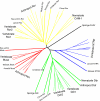Ror receptor tyrosine kinases: orphans no more
- PMID: 18848778
- PMCID: PMC4672995
- DOI: 10.1016/j.tcb.2008.08.006
Ror receptor tyrosine kinases: orphans no more
Abstract
Receptor tyrosine kinase-like orphan receptor (Ror) proteins are a conserved family of tyrosine kinase receptors that function in developmental processes including skeletal and neuronal development, cell movement and cell polarity. Although Ror proteins were originally named because the associated ligand and signaling pathway were unknown, recent studies in multiple species have now established that Ror proteins are Wnt receptors. Depending on the cellular context, Ror proteins can either activate or repress transcription of Wnt target genes and can modulate Wnt signaling by sequestering Wnt ligands. New evidence implicates Ror proteins in planar cell polarity, an alternative Wnt pathway. Here, we review the progress made in understanding these mysterious proteins and, in particular, we focus on their function as Wnt receptors.
Figures




Similar articles
-
Wnt signaling through the Ror receptor in the nervous system.Mol Neurobiol. 2014 Feb;49(1):303-15. doi: 10.1007/s12035-013-8520-9. Epub 2013 Aug 30. Mol Neurobiol. 2014. PMID: 23990374 Review.
-
The conserved transmembrane RING finger protein PLR-1 downregulates Wnt signaling by reducing Frizzled, Ror and Ryk cell-surface levels in C. elegans.Development. 2014 Feb;141(3):617-28. doi: 10.1242/dev.101600. Epub 2014 Jan 8. Development. 2014. PMID: 24401370 Free PMC article.
-
Ror-family receptor tyrosine kinases in noncanonical Wnt signaling: their implications in developmental morphogenesis and human diseases.Dev Dyn. 2010 Jan;239(1):1-15. doi: 10.1002/dvdy.21991. Dev Dyn. 2010. PMID: 19530173 Review.
-
A Wnt-Frz/Ror-Dsh pathway regulates neurite outgrowth in Caenorhabditis elegans.PLoS Genet. 2010 Aug 12;6(8):e1001056. doi: 10.1371/journal.pgen.1001056. PLoS Genet. 2010. PMID: 20711352 Free PMC article.
-
The role of Ryk and Ror receptor tyrosine kinases in Wnt signal transduction.Cold Spring Harb Perspect Biol. 2014 Feb 1;6(2):a009175. doi: 10.1101/cshperspect.a009175. Cold Spring Harb Perspect Biol. 2014. PMID: 24370848 Free PMC article. Review.
Cited by
-
Loss of receptor tyrosine kinase-like orphan receptor 2 impairs the osteogenesis of mBMSCs by inhibiting signal transducer and activator of transcription 3.Stem Cell Res Ther. 2020 Mar 26;11(1):137. doi: 10.1186/s13287-020-01646-2. Stem Cell Res Ther. 2020. PMID: 32216811 Free PMC article.
-
Multiple requirements of the focal dermal hypoplasia gene porcupine during ocular morphogenesis.Am J Pathol. 2015 Jan;185(1):197-213. doi: 10.1016/j.ajpath.2014.09.002. Epub 2014 Nov 3. Am J Pathol. 2015. PMID: 25451153 Free PMC article.
-
miR-27b-3p suppresses cell proliferation through targeting receptor tyrosine kinase like orphan receptor 1 in gastric cancer.J Exp Clin Cancer Res. 2015 Nov 14;34:139. doi: 10.1186/s13046-015-0253-3. J Exp Clin Cancer Res. 2015. PMID: 26576539 Free PMC article.
-
Dysregulated Wnt Signalling in the Alzheimer's Brain.Brain Sci. 2020 Nov 24;10(12):902. doi: 10.3390/brainsci10120902. Brain Sci. 2020. PMID: 33255414 Free PMC article. Review.
-
The C. elegans Chp/Wrch Ortholog CHW-1 Contributes to LIN-18/Ryk and LIN-17/Frizzled Signaling in Cell Polarity.PLoS One. 2015 Jul 24;10(7):e0133226. doi: 10.1371/journal.pone.0133226. eCollection 2015. PLoS One. 2015. PMID: 26208319 Free PMC article.
References
-
- Matsuda T, et al. Expression of the receptor tyrosine kinase genes, Ror1 and Ror2, during mouse development. Mech Dev. 2001;105(1-2):153–6. - PubMed
-
- Masiakowski P, Carroll RD. A novel family of cell surface receptors with tyrosine kinase-like domain. J Biol Chem. 1992;267(36):26181–90. - PubMed
-
- Reddy UR, Phatak S, Pleasure D. Human neural tissues express a truncated Ror1 receptor tyrosine kinase, lacking both extracellular and transmembrane domains. Oncogene. 1996;13(7):1555–9. - PubMed
-
- Al-Shawi R, et al. Expression of the Ror1 and Ror2 receptor tyrosine kinase genes during mouse development. Dev Genes Evol. 2001;211(4):161–71. - PubMed
-
- Oishi I, et al. Spatio-temporally regulated expression of receptor tyrosine kinases, mRor1, mRor2, during mouse development: implications in development and function of the nervous system. Genes Cells. 1999;4(1):41–56. - PubMed
Publication types
MeSH terms
Substances
Grants and funding
LinkOut - more resources
Full Text Sources
Other Literature Sources

